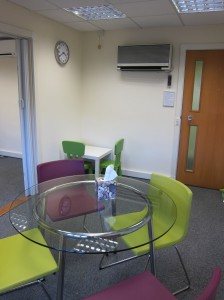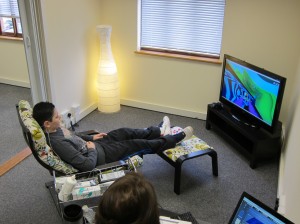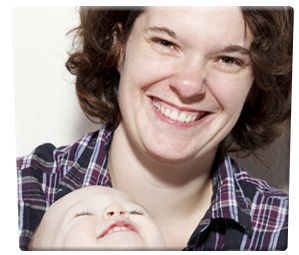Frequently Asked Questions
Answers to the top questions about Neurofeedback.
1. If it works so well, why haven’t I heard of Neurofeedback?
2. What is the brain training experience like?
3. How effective is brain training, what kind of results can I expect?
5. Are there any side effects to the BrainTrainWA programme?
6. How soon will I feel a benefit and how many sessions will I need?
7. Is Neurofeedback beneficial for everyone?
8. What are your qualifications and how up to date is your equipment ?
9. What are the different types of Neurofeedback?
10. What’s different about Infra-Low Frequency (ILF) Neurofeedback ?
13. What does the NHS say about Neurofeedback?
14. Is there any research going on in the UK on Neurofeedback ?
15. Is it possible to complete the brain training program from home?
16. How many electrodes do you use?
1. If it works so well, why haven’t I heard of Neurofeedback?
Neurofeedback intersects Medicine, Psychiatry and Psychology, but isn’t owned by any of these fields. So today it isn’t is taught at Medical School, Psychology faculty, or Psychiatry specialist training.
In asking ‘Why do Doctors fail’, the respected US doctor and writer Atul Gawande describes this as ineptitude – the knowledge exists but isn’t applied everywhere it could help.
Despite the evidence of the power of Neurofeedback going back 40 years, it was only in the last few years that conventional science has accepted that the brain could change – a concept now known as Neuroplasticity. Before this was accepted the idea that Neurofeedback could change the brain was officially ‘impossible’ despite the overwhelming evidence. Not only has science finally caught up with what many have known to be true for decades, the cost of bringing these treatments to you had been very high. Highly complex and large equipment cost millions to own and operate. With advances in digital technology, gaming software and processes refined over many years, Neurofeedback has now become a commercially viable treatment option.
Most importantly, the understanding of the best clinical approaches and equipment design for brain training has improved to the point where several thousand Neurofeedback Practitioners are using this technology in the USA to help clients improve their brain function. Although individual practitioners have been carrying out Neurofeedback in increasing numbers in the USA, Canada, continental Europe and Australia, it is still relatively unheard of in these countries, and not quite mainstream. In the UK, BrainTrainWA aims to raise awareness and enable thousands of people to benefit from this drug-free, natural approach.
2. What is the brain training experience like?
Clients enjoy the Neurofeedback sessions. The brain is curious about the feedback and seems to remain interested even when some repetition is necessary to train your brain to become better at self-regulation.
Electrode sensors will be attached to your head to monitor your brain waves. This involves cleaning the scalp with an alcohol swab and attaching the sensors using a special paste, similar in consistency to Vaseline. Feedback to your brain is provided through the use of video, audio and if you choose, touch. You can choose your method of feedback from session to session, but usually people settle on a preferred method. There is a choice of video games that you ‘control’ with your brain, from very simple ‘pong’ type games to car racing and jet ski games. You can also choose from a range of documentaries, TV shows or music videos, in fact any DVD you want to bring along or YouTube videos. We are not restricted to particular movies.
The video will go faster, louder or bigger as the brain changes state. As you relax, the brain is able to ‘tune in’ to the feedback and adjust in response. This all happens subconsciously, which means you don’t consciously try to direct the brain one way or another, but just relax and allow the brain to use it’s own ability to self-regulate. See more details here.
3. How effective is brain training, what kind of results can I expect?
Studies have repeatedly shown Neurofeeedback to be effective in a wide variety of clinical applications as well as for peak performance. In cases where Neurofeedback is an alternative to medication, Neurofeedback brain training is not only safer than medication as there are no dangerous side effects, the benefits of the treatment also remain after the programme has finished. With medication you are simply controlling the symptoms, not solving the problem.
We take the time to understand your home and work environments and help you ensure they are supportive of the treatment. But like with any form of training, Neurofeedback brain training needs you to be motivated and committed to the training programme. It doesn’t work for everyone however, and the only way to find out if it works or not is to try it.
4. Is it safe?
Absolutely. In fact, no one has been harmed since Neurofeedback began in the 1950s. The sensors we attach to your scalp are simply there to listen to the brain; there is no stimulation or signal transmitted by the equipment. The brain does all the real work, adapting in response to the feedback.
5. Are there any side effects to the BrainTrainWA programme?
There are no side effects in the conventional sense because the training is non-invasive and does not involve any medication whatsoever. Because everyone is different, your Neurofeedback Practitioner will carefully monitor how your symptoms react to the training. Checking, for example, your sleeping patterns to ensure you are given the ideal treatment. If, for example, you developed a headache during an early training session your Practitioner will adjust the feedback settings to modify the reward frequency, ensuring that future sessions are free from discomfort. Although clinical-grade Neurofeedback is certainly not a toy, in the hands of skilled and responsible practitioners you should be confident that any side-effects can be minimised and overcome.
6. How soon will I feel a benefit and how many sessions will I need?
Clients often feel different after just the first session, although it will take multiple sessions for the new ways of working to be fully learned by the brain. Just as different people learn at different rates, so do different brains, and some have more to learn than others. The spiral in our logo represents how each session builds upon the previous ones to accumulate the benefits. We ask that you commit to 20 sessions; this will deliver significant, lasting improvements for most clients. If your condition is particularly serious you may wish to continue beyond 20 sessions, but this is something you would discuss with your Neurofeedback Practitioner towards the end of your first course.
7. Is Neurofeedback beneficial for everyone?
In most cases Neurofeedback promotes a learning process and long-term improvements are expected. Neurofeedback is a learning process, so the environment needs to be supportive of learning, the brain needs to be physically fit to be able to learn, and there has to be a motivation to learn. If you attend French classes you will be successful only if you are motivated to learn. Reasons when Neurofeedback could be less beneficial or not beneficial at all entail food intolerances, dietary insufficiencies, digestive malabsorption, heavy metal toxicities or excesses in certain minerals, the Irlen Syndrom and other disturbances in visual processing, a primary auditory processing disorder, deficits in blood glucose regulation (dysglycemia), poor sleep or poor sleep hygiene, where degenerative conditions prevail, structural injury in the brain (i.e. stroke injury; brain tumour; arteriovenous malformations; hydrocephalus; history of meningitis, etc.) and cerebral under-perfusion. Another important factor that could impact the level of improvement are environmental factors within the home or school that hinder training success: emotionally unsettled or even a traumatizing home environment; being subjected to bullying behaviour at school, etc. In these cases the brain needs to ‘survive’ and there is little room for ‘learning’. For more detailed information about factors that could impact the benefits of Neurofeedback, please click here.
8. What are your qualifications and how up to date is your equipment ?
As the UK’s leaders in the Neurofeedback field, we have very close relations with EEG Info, the world’s leaders in Neurofeedback for therapeutic applications. With BrainTrainWA you can be confident that as soon as the latest upgrade is released, we will be offering it. BrainTrainWA uses the methodology and equipment taught, developed and practiced by EEG Info, the organisation created by Dr Siegfried and Susan Othmer, pioneers who have led the field of clinical practice, equipment and trained thousands of people in Neurofeedback in the last 25 years. The equipment is constantly updated, we were among the first to receive the latest hardware in December 2012, and the software is continuously updated. We were part of the final testing programme for the latest version in November 2015.
We chose this as our primary treatment modality, but also integrate BrainMaster technology including QEEG analysis, Z-Score Training and BrainAvatar sLORETA brain imaging as appropriate. With BrainTrainWA you don’t have to choose one technology or another, just trust us to have access to whatever’s right for your case. Our founder’s engineering background enables us to cut through the marketing claims, continuously review the technologies and methodologies, challenge the boundaries and ensure BrainTrainWA clients always get the best.
Whilst our technology is the most advanced and progressive in the field, we shouldn’t forget that the most complicated part of the feedback system is the brain, and every client is different. So we believe the most important skill is the ability to take a client-centric approach to training. Our approach has been developed and refined over more than 20 years and continues to do so, led by clinical practice, making our approach the leading 21st century Neurofeedback approach based around the whole client.
We see Neurofeedback as an important part of medicine that the medical community are still learning about. We complement and augment conventional medicine, collaborate with the existing healthcare system, are members of the Royal Society of Medicine and have strong relationships with world-leading Dieticians, General Practitioners and Specialist Consultants.
Our experience at the highest levels of private and public healthcare means we lead the field in integrating Neurofeedback with your overall healthcare experience. All of our Neurofeedback Practitioner professionals have qualifications in Neurofeedback theory, equipment and practice and have attended residential training courses personally taught by the Othmers and their clinical staff. We supplement these with qualifications in Psychology, Educational Psyschology and Coaching. We also take part in regular supervisory calls with Susan Othmer who has been described as ‘the best Neurofeedback clinician in the World’, and any of our practitioners can schedule a personal call with Sue at any time.
With BrainTrainWA you are getting the best – delivered by the best – supported by the best – why choose anyone else ?
9. What are the different types of Neurofeedback ?
Neurofeedback has evolved in different directions over its 40 year history and it can be difficult to choose, as every approach makes their own claims on how they are different. The good news is with BrainTrainWA you don’t need to choose one or the other as we have access to them all – we offer a ‘best of breed’ approach that we continue to develop.
Traditional Neurofeedback
Original protocols used a ‘one size fits all’ approach. Everyone received the same Neurofeedback training based upon an understanding of what protocols work on a general basis. They don’t assume that the goal should be a certain ‘average’, they focus on maximising brain activity in certain ways. Although it has been around for a long time, this approach has value and is still used by the most expensive Neurofeedback training in the world at the Biocybernaut Institute, at $15,000 for a week of intensive training.
QEEG-Guided Neurofeedback (also known as 3G or QEEG LoRETA)
Some Neurofeedback practices focus on the idea of using a Quantitative Electroencephalogram (QEEG) which compares your brainwaves with ‘average’ brainwaves for your age and can display ‘3D’ images that show how your brainwaves compare with the ‘average’, using an open source algorithm called ‘LoRETA’.
You also get a written report with lots of data and diagrams that show how you brainwaves compared with the ‘average’ but little if any information on what your QEEG means.
The limitation with this approach is it assumes there is such a thing as an ‘average’ brain that we should all aspire to. Our experience is that high-performing executives, peak athletes or autistic children do not have an ‘average’ brain and our focus is not on ‘averaging’ but building on strengths and reducing limitations.
However, there is no doubt that 3D-QEEGs create very cool images and some clients find it empowering to see how their electrical brain activity compares with the ‘average’. So BrainTrainWA also offers …
QEEG-Interpreted Neurofeedback (also known as 3G or QEEG LoRETA)
Rather than give you a report that simply compares your electrical brain activity with the theoretical ‘average’, we give you an interpretative report that puts your QEEG into context, that you will find far more useful, and can be an input into your individualised Neurofeedback Plan.
We don’t need a QEEG to deliver endogenous Neurofeedback (see below), but if we do a QEEG this approach is the one used by BrainTrainWA and some other specialist Neurofeedback practitioners.
Endogenous (Infra Low Frequency) Neurofeedback
2 generations on from QEEG-Guided Neurofeedback, we have the capability to train at Infra Low Frequencies, where we are training the core control networks of the nervous system, using the nervous systems’ inherent ability to self-regulate to maximise performance.
We don’t ‘tell’ the brain how to change based upon 20 year-old databases as with QEEG-Guided, we use the much more powerful approach of using the brains’ own ability to learn through neuroplasticity. Some of the key differences between Infra-Low Frequency Neurofeedback and QEEG-Guided Neurofeedback:
|
QEEG-Guided NF aka 3D or LoRETA Neurofeedback |
Infra-Low Frequency NF | |
|---|---|---|
| Focus | Brainwave averaging | Symptom improvement and performance maximisation |
| Objective | Average brain performance | Maximum brain performance |
| Mechanism | Operant Conditioning discovered 50 years ago – tell the brain how it should change to become ‘average’ | Endogenous Neuromodulation first available in 2012 – give the brain information to enable the brain’s natural ability to self-regulate and change itself through neuroplasticity |
| Reference database | 20 years old | Not applicable – assumes that every brain is unique |
| Reward frequencies | Traditional frequency bands Alpha, Beta, Gamma, Delta, Theta | Infra-Low Frequencies, the core control networks of the nervous system |
The questions you need to ask yourself when making a decision about which approach to Neurofeedback is best for you are:-
- Do I want to be average OR the best I can be ?
- What do I really care about ? Making my brain waves average ? OR maximising performance and relief from symptoms ?
- Would I rather use a computer database to ‘tell’ my brain how to change OR use my brain’s natural ability to self-regulate to change itself through neuroplasticity ?
- Often children with learning difficulties have specific talents that are far from average – do you want your children to be ‘average’ or to make the most of their talents ?
- What would a QEEG-based approach make of the brains of Richard Branson, Albert Einstein, Steve Jobs or Bill Gates ? Would they be average or would the QEEG suggest their brains were ‘abnormal’ ?
The questions you need to ask Neurofeedback practitioners when making a decision about which approach to Neurofeedback is best for you are:-
- How does your approach compare with Infra-Low Frequency Neurofeedback ?
- Do you have evidence for any specific claims that your approach is better than others ?
BTUK Leading-Edge Approach to Neurofeedback
Our latest approach combines QEEG-Informed NF and Infra Low Frequency NF and is unique to BrainTrainWA. We don’t use this in all cases as it is not necessary, but if for example a client presents with a history of or suspicion of brain injury we might recommend it. In cases of brain injury, which could be a knock on the head that resulted in mild concussion but impacted brain function, we can see more specifically the area(s) where brain function is impaired, and use this Brain Map to give us more specific information on placements, which allows us to more effectively target training to remediate damaged brain functions with the Infra-Low Frequency training.
We use $20,000 worth of BrainMaster equipment (3D Neurofeedback) to conduct a ‘Brain Map’. Brain Maps cost an additional £349 if we do them in London, £249 if we do them in Milton Keynes, including written report and telephone de-brief.
10. What’s different about Infra-Low Frequency (ILF) Neurofeedback ?
Leading-edge research in the world of Neurofeedback is investigating the possibility of using functional magnetic resonance imaging (fMRI) to provide real-time feedback. The exciting thing about fMRI research is that by presenting live images of their own brain activity to participants and challenging them to change the activity level in certain brain regions, they can restructure brain patterns in a single session.
fMRI Neurofeedback is so powerful because it is working on the primary regulatory networks or resting-state networks, the core control networks of the nervous system. However, the practical application of fMRI-based neurofeedback is handicapped by the fact fMRI scanners cost £millions and weigh tons. But thanks to the work done with fMRI neurofeedback and the identification of the resting-state networks in the EEG, this same mechanism is now available through EEG neurofeedback, in the form of Infra-Low Frequency (ILF) Neurofeedback.
ILF is the latest generation of Neurofeedback and takes the capability of Neurofeedback beyond the so-called ‘deep-brain training’ of LoRETA. The term ‘Infra-Low’ comes from the fact that the frequencies being rewarded are below 0.1Hz, well below the traditional Neurofeedback reward frequencies. Before these frequencies were identified through fMRI experiments they were not identified in the EEG, and are ignored by most modern forms of Neurofeedback. Only available commercially since 2012, ILF is a modality of neurofeedback in the category of ‘endogenous neuromodulation’, which means that any changes are solely due to information being provided to the brain on its own state. In other words, the training doesn’t encourage the brain to shift itself in any particular direction, it just gives information back to the brain, an analogy is showing the brain itself in a ‘mirror’, often for the first time.
ILF Neurofeedback reaches deep into the hierarchy of nervous system regulation, providing feedback on the brain’s primary regulatory networks or resting state-networks, the core control networks of the nervous system. Initially the brain recognises its connection with the feedback signal, and then the signal becomes the object of control by the brain. A feedback loop has been established that allows the brain to enhance its own capacity for self-regulation. The brain’s natural development depends on similar feedback loops being established within the brain.
ILF Neurofeedback gives the brain more information, more directly, accelerating the learning process. By targeting we can focus on particular functions or competencies we would like to improve.
11. How much does it cost?
When using any type of service we think you should know exactly what you’re paying. Small print and hidden costs annoy us as much as they annoy you. Our fees are simple. We offer ‘Pay as You Go’ (PAYG) prices payable weekly or monthly in advance, but offer significant price incentives if you book a package and pay in advance.
| Pay As You Go Prices | ||
|---|---|---|
| Initial Consultation |
£75 |
|
| Initial Assessment & Neuro Programme design | £120 | |
| Individual Neurofeedback Sessions (30 minutes of Neurofeedback) | £90 per 30 min session | |
| QEEG Brain Mapping and Report (if required)* | £349 in London | |
| QEEG Brain Mapping and Report (if required)* | £249 in Milton Keynes | |
The Initial Consultation is charged at £75 and includes a trial session of Neurofeedback. If you go ahead with further Neurofeedback this is credited against your first payment so becomes effectively ‘free’.
| Package Prices | ||
|---|---|---|
| Package (all include Initial Assessment & Neuro Programme Design) | Launch price | |
| Neurofeedback 20 Session package | £1500 | |
| Neurofeedback 10 Session package | £850 | |
| Neurofeedback 3 Session’Taster’ | £299 | |
We recommend you commit to 20 sessions (each session taking approximately 45 minutes from arrival to departure). This ensures there is enough training for the brain to learn and begin to self-regulate effectively. Most clients are also suitable for ‘double sessions’ that last 75 minutes from start to finish. If you are not ready to commit to 20 sessions we also offer a 10 session package.
For those who are unsure if Neurofeedback is for them, we also offer a Neurofeedback ‘Taster’ Programme which consists of an Initial Assessment, Neuro Programme Design and 3 trial Neurofeedback sessions, at a significant discount on the PAYG price. It should be stressed results should not be expected from so few sessions, but this programme is suitable for those serious about Neurofeedback who plan to upgrade to the 10 or 20 session package if the ‘Taster’ sessions are comfortable. We are offering an additional Launch Discount which reduces the price to £75 per session when you book a 20 Session Package and pay in advance, including the Initial Assessment and Individual Neuro Programme Design.
* Whilst a Brain Map is not necessary for Infra-Low Frequency Neurofeedback, some clients appreciate the insight that it can give them on how their brainwaves conpare to the norm, and it can be useful where brain injury is present or suspected, providing additional information to guide the Neuro Programme Design. If you have any questions about our fee structure, please call us today on 0207 978 0186 or email us here.
London Brain Mapping appointments are usually in Harley Street. Other sessions in Harley Street are an additional £30 per session.
12. Where can I do it ?
Click on locations below for more details. Call us on 0207 978 0186 for your free no-obligation initial appointment today. We continue to expand into other areas and have waiting lists so we can better understand the demand in different areas, so please get in touch to find out if we’re able to help you now or in the future. 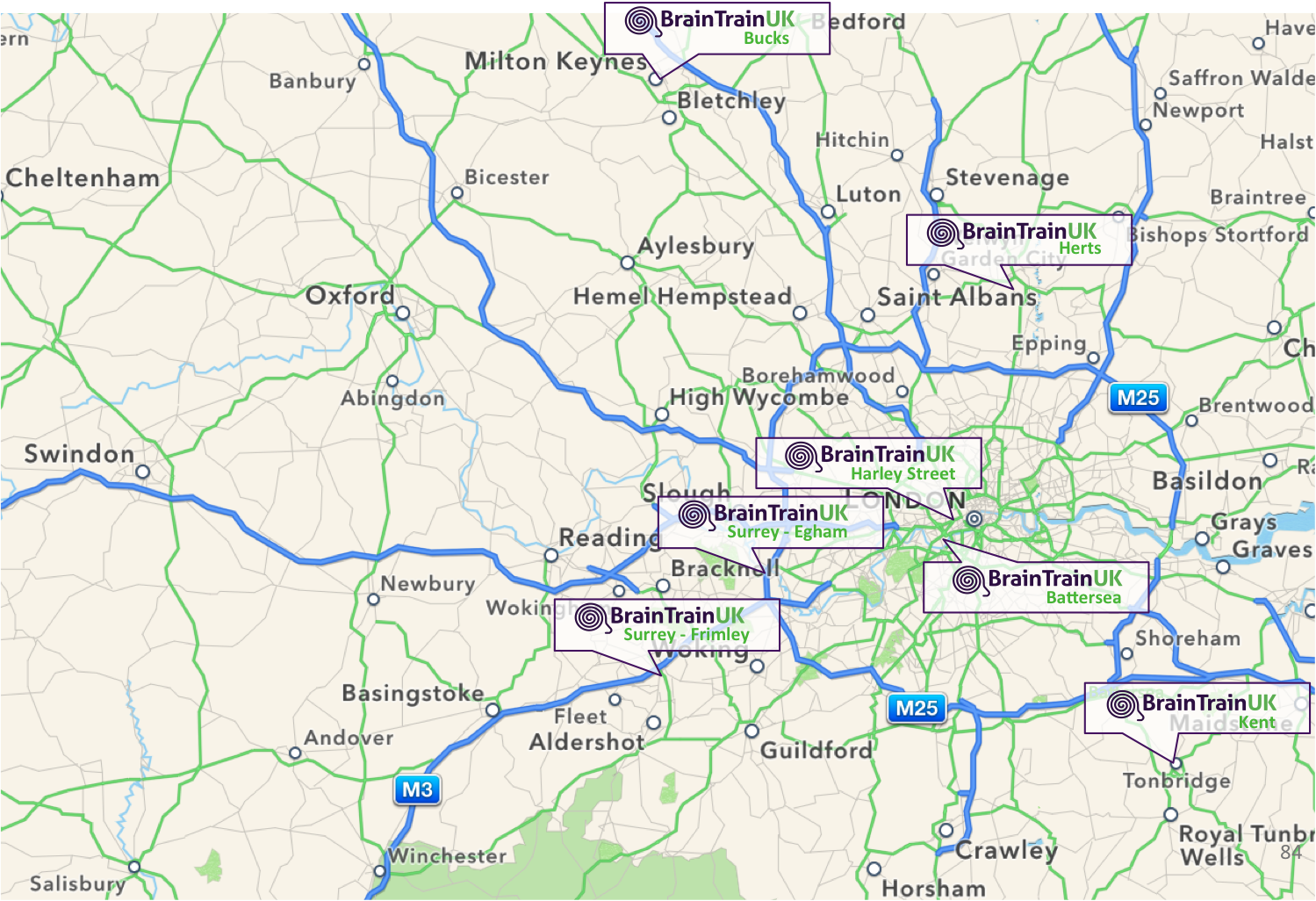
We practise in London, Surrey, Kent, Hertfordshire, and Buckinghamshire. We have treatment centres in London’s Harley Street, Battersea (Clapham Junction), Egham in Surrey, Frimley on the Surrey/Hampshire/Berkshire border and Hoddesdon in Hertfordshire and Tonbridge in Kent. We also have regular clinics in Milton Keynes. We can also offer mobile Neurofeedback services if there is more than one client in a particular area. We offer you a range of flexible treatment programmes to make traveling to one of our clinics more convenient for you. We always do everything possible to accommodate your needs and plan around your busy schedule.
Can we help you in your area? Find out with a quick call to check our latest plans now on 0207 978 0186.Battersea, London
BrainTrainUK London is based in Battersea, 7 minutes walk from Clapham Junction Station, 1 mile from the Kings Road and 3 miles from Kensington. Street pay parking is available. You can download directions from Clapham Junction Station or directions and parking information if you are driving, or bus route information. Click for a BrainTrainWA London Leaflet.
BrainTrainWA London Penhurst House 352 – 356 Battersea Park Road London SW11 3BY.
Call us today on 0207 978 0186 to book your free no-obligation initial appointment in Battersea. Call us today on 0207 978 0186 to book your free no-obligation initial appointment in Battersea.Harley Street, London
BrainTrainWA London (Harley Street) is located at the South end of Harley Street, close to Oxford Circus & Bond Street tube stations and the Royal Society of Medicine. We should explain we have limited availability in Harley Street and charge an additional £30 a session. However we are operational 7 days a week in Battersea which is a short tube/train/taxi away – see above. BrainTrainWA London (Harley Street) Room 5 7 Harley Street London W1G 9QD 
Egham, Surrey
BrainTrainWA Egham is easily accessible by both road (1 mile to M25 J13, 2 miles to M3/M25 junction) and rail (Waterloo 37 minutes, Richmond 20 minutes, Ascot 13 minutes). We recommend you download our directions if travelling by car as we have found Sat Nav systems can get confused. Here are directions from Egham Station, from the A30, and from the M25 Junction 13. Click for a BrainTrainWA Surrey Leaflet.
Call us today on 0207 978 0186 to book your free no-obligation initial appointment in Egham. Call us today on 0207 978 0186 to book your free no-obligation initial appointment in Egham.
Frimley, Surrey
BrainTrainWA Frimley is 5 minutes from J4 of the M3 and is based at Bright Sparks Montessori School. BrainTrainWA Frimley Bright Sparks Montessori School Gilbert Road Frimley GU16 7RE.
Hoddesdon, Herfordshire
BrainTrainWA Hertfordshire is just 27 mins from Liverpool Street and 6 miles from M25 J26. BrainTrainUK Hertfordshire 6a Limes Court Conduit Lane Hoddesdon EN11 8EP Herts
Tonbridge, Kent
BrainTrainWA Kent is based in Tonbridge, just off the A21 and within training distance of many parts of Kent, East and West Sussex. Led by Jo-Anne Buttle, who also offers Educational Psychology services through her well-established practice: BrainTrainWA Kent Nuthurst 11 Old Hadlow Road Tonbridge Kent TN10 4EY.
Milton Keynes, Bucks
BrainTrainWA Bucks is based in Newport Pagnell, just off the M1 and within easy travel of Buckinghamshire and Northamptonshire. BrainTrainWA Bucks Spark Way Newport Pagnell Bucks MK16 8RE.
We will continue to expand into other areas of the UK and are now beginning to establish waiting lists so we can better understand the demand in different areas, so please get in touch to find out if we’re able to help you now or in the future. We offer you a range of flexible treatment programmes to make travelling to one of our clinics more convenient for you. We always do everything possible to accommodate your needs and plan around your busy schedule.
13. What does the NHS say about Neurofeedback?
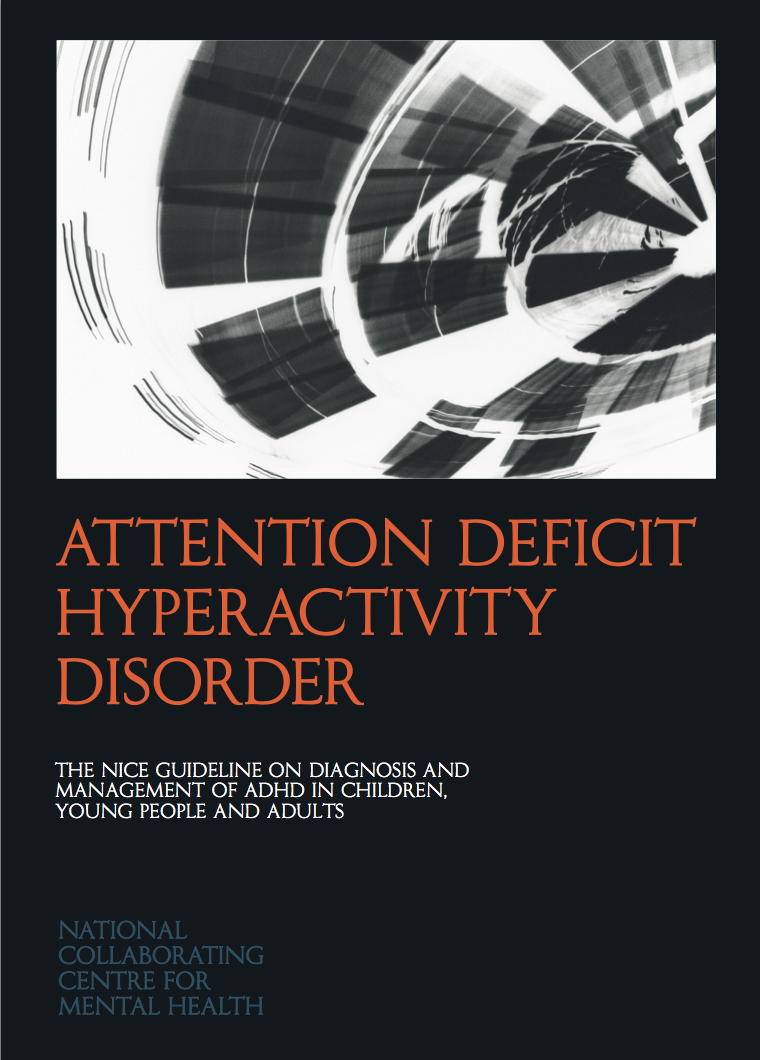 Not much, although it is positive. There is a ‘chicken and the egg’ effect that means whilst the NHS do not pay for Neurofeedback for ADHD, it is not widely practised. The last full guidelines on ADHD were published by NICE (National Institute for Health and Care Excellence) in 2009. The full guidelines (646 pages) can be found here. They don’t say much about Neurofeedback, but what they do say is objective and non-critical, though a little out of date with research references. A key sentence is “Biofeedback has been employed as a non-invasive treatment for children with ADHD since the 1970s but is probably not used as a significant intervention in UK clinical practice.” We reproduce the text on Page 202 of the Guidelines here:-
Not much, although it is positive. There is a ‘chicken and the egg’ effect that means whilst the NHS do not pay for Neurofeedback for ADHD, it is not widely practised. The last full guidelines on ADHD were published by NICE (National Institute for Health and Care Excellence) in 2009. The full guidelines (646 pages) can be found here. They don’t say much about Neurofeedback, but what they do say is objective and non-critical, though a little out of date with research references. A key sentence is “Biofeedback has been employed as a non-invasive treatment for children with ADHD since the 1970s but is probably not used as a significant intervention in UK clinical practice.” We reproduce the text on Page 202 of the Guidelines here:-
“Biofeedback has been employed as a non-invasive treatment for children with ADHD since the 1970s but is probably not used as a significant intervention in UK clinical practice. A wide range of feedback presentations that are suitable for children are available and its rationale lies in theories of brain plasticity and cortical self-regulation that suggest it may be possible to countermand deficits of cortical activation (see Heinrich et al., 2006). The use of electro-encephalography (EEG) biofeedback derived from the initial hypothesis of Satterfield and colleagues (Satterfield & Dawson, 1971; Satterfield et al., 1973) that attentional deficits result from dysfunction of the central nervous system and that children with ADHD exhibit behaviours consistent with ‘low arousal’. It is assumed that variations in alertness and behavioural control are directly related to specific thalamocortical generator mechanisms and that such variations are evident in distinctive EEG frequency rhythms that emerge over specific topographic regions of the brain (Sterman, 1996).
It is proposed that ADHD neuropathology could alter these rhythms and that EEG biofeedback training directed at normalising these rhythms might therefore yield sustained clinical benefits. Biofeedback techniques thus involve training individuals to exercise a certain amount of control over their brainwaves (as recorded by EEG) through bioelectrical neuroregulation. The mechanism by which it is proposed that this can be achieved is based on the assumption that the central nervous system can regulate a series of phys-iological functions in addition to its own activity.
Intentional modulation of cortical self-regulation is achieved through a process of operant learning through the provision of training aimed to decrease excessive theta or slow wave activity (which is associated with feeling drowsy) and increase beta activity (which is associated with ‘alertness’ and attentional and memory processes). Biofeedback training involves the clinician setting desired thresholds on the biofeedback equipment. These thresholds are based on treatment goals, for example to decrease theta rhythm and increase beta rhythm.
As the individual’s physiological changes approach and surpass the set thresholds, the equipment provides either auditory or visual feedback, which serves as positive reinforcement for the desired changes. Thus, as an individual decreases theta and increases beta waves during EEG biofeedback, reinforcement is provided to encourage them to become more aware of what they are doing to achieve this desired state and to continue in the same manner. In children a focus has been on the training of slow cortical potentials as well as theta and beta waves, and the use of a computer- based delivery seems to assist with the acceptability of the method.”
NICE have begun a process to conduct a full review of the Clinical Guidelines. BrainTrainWA is a registered stakeholder in the review process and NICE have confirmed they have received the evidence and business case prepared by BrainTrainWA. We were the only representatives of Neurofeedback at the stakeholder review of the Scope in December 2015 and NICE closed consultation on the Scope 5th February 2016. We can confirm that Neurofeedback is within Scope of the review. Publication of the next full guidelines is currently forecast for late 2017.
14. Is there any research going on in the UK on Neurofeedback ?
Yes. The World-leading Institute of Psychiatry at King’s College London are doing research on the possible next generation of Neurofeedback, looking at using functional MRI’s to gather information on brain activity instead of EEG (electrodes attached to the head). Led by Professor Katya Rubia, in response to the Question ‘Why Undertake This Research’ the researchers respond as follows: (Note the sentence we have highlighted) “Medication helps around 70% of children with ADHD, but it is far from perfect. Medication is associated with side effects such as restricted growth, loss of appetite and disturbed sleep. What’s more, while medication is often highly effective in the short term, there is little evidence that it helps in the longer term and benefits are immediately lost if children stop taking their medication. Neurofeedback using a more basic imaging tool like EEG has been shown to be effective in reducing the symptoms of ADHD. In this study we aim to test the efficacy of Neurofeedback using a modern imaging tool, i.e. FMRI, which we believe will be more effective and be able to target the key brain regions that are not optimally working in ADHD.” It should be stressed that this is very early stage research, even if the outcome were favourable there are significant issues like the current cost of MRI scanning (typically £500 per scan which could add £8,000- £10,000 to the cost of a typical NF programme). It is at a similar experimental stage that EEG Neurofeedback was in the 1970s. The main point is that Action Medical Research for Children would not be funding this new research to the tune of £197,365 unless they believed research had already established that EEG Neurofeedback as practiced by BrainTrainWA works for ADHD symptoms. We are also engaged with the world-leading research team for EEG Neurofeedback for ADHD, led by Vince Monastra and Joel Lubar, to introduce them to a UK hospital to further the body of research.
15. Is it possible to complete the brain training program from home?
Provided you are confident using a PC, and are able to attend several in-person sessions initially, it is possible for you to deliver the balance of the training program at home by borrowing the equipment. This allows a potentially more frequent training program without the need to travel. We would have to be confident that you were able to master the skills necessary, would set a time limit on the loan, and would require regular updates of symptoms and regular progress calls with your Practitioner. Please contact us if this would be of interest.
16. How many electrodes do you use?
This question is like asking a train company how many horses they use – it comes from a previous mindset.
The idea that by collecting information from 19 electrodes and providing feedback simultaneously is superior to a focused bipolar montage using 4 electrodes is like suggesting you can train all your muscles simultaneously!
The reality is that all Neurofeedback training information is simple. In the old days this was a red light or a green light. These days the feedback information is still very simple but is presented in more sophisticated ways.
If you are tempted by the implication that 19-channel feedback is fundamentally different then we suggest you ask how the feedback differs before you pay more.
Have we answered your question? If not, please get in touch with us here at BrainTrainWA. You’ll be able to speak to one of our friendly experts who will be happy to help you, simply call today on 0207 978 0186.
To read more about this, please read the next page About Us




